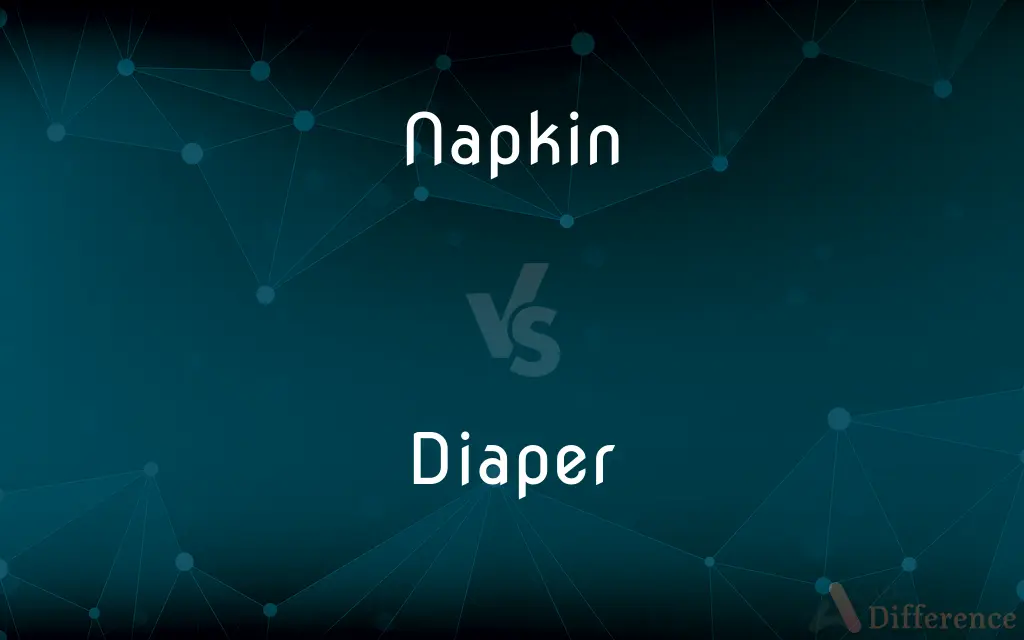Napkin vs. Diaper — What's the Difference?
By Tayyaba Rehman & Maham Liaqat — Updated on April 24, 2024
Napkins are disposable or cloth fabrics used primarily for wiping the mouth and hands during dining, whereas diapers are absorbent garments worn by infants or adults with incontinence to contain urine and feces.

Difference Between Napkin and Diaper
Table of Contents
ADVERTISEMENT
Key Differences
Napkins are designed for cleanliness and decorum at the dining table, used to protect clothing from spills and to wipe the mouth and hands, while diapers are specifically engineered to absorb and contain bodily wastes, providing hygiene and comfort for wearers. Napkins come in a variety of materials, including paper and cloth, each selected for their particular use during meals. Diapers, on the other hand, are generally made from highly absorbent materials and contain waterproof layers to prevent leaks.
Diapers are essential for babies and certain adults, serving as a hygienic necessity that allows for mobility and comfort. Napkins, though often used daily, do not serve a critical function in personal hygiene to the same extent as diapers. While napkins are frequently part of table settings and can be selected for aesthetic purposes, diapers are chosen based on absorbency, fit, and comfort.
The use of napkins is transient, typically only during meal times or occasionally for cleaning small spills, whereas diapers are used continuously throughout the day and night until potty training is achieved or during necessary periods for adults. This reflects the non-stop dependency on diapers for infants and some adults, contrasting with the occasional use of napkins.
Culturally, napkins hold a place in formal dining etiquette, emphasizing manners and cleanliness, whereas diapers are discussed in contexts of health care, child care, and adult care, stressing functional needs over aesthetic considerations.
Comparison Chart
Primary Use
Cleaning the mouth and hands during dining
Absorbing and containing urine and feces
ADVERTISEMENT
Material
Cloth or paper
Absorbent material with waterproof layers
Duration of Use
Temporary during meals
Continuously until no longer needed
Cultural Association
Dining etiquette, cleanliness
Health care, child care, adult care
Importance
Aesthetic and practical during meals
Essential for hygiene and comfort
Compare with Definitions
Napkin
Part of table etiquette in many cultures.
Using a napkin correctly is part of basic table manners in many societies.
Diaper
A garment worn by infants and some adults, designed to absorb and contain urine and feces.
The baby slept through the night without needing a diaper change.
Napkin
Often used in settings of formal dining to enhance table decor.
The silver napkin rings added a touch of elegance to the dinner table.
Diaper
Typically includes features like elastic waistbands and adhesive tabs for a secure fit.
The diaper's adhesive tabs make it easy to adjust for a comfortable fit.
Napkin
Can be made from various materials, primarily focusing on absorbency and reusability.
He preferred cloth napkins over paper because they were more environmentally friendly.
Diaper
Available in various sizes and types to accommodate different age groups and needs.
As her child grew, she switched from newborn to size three diapers.
Napkin
Disposable versions are popular in casual dining establishments.
Paper napkins are often provided in large stacks at fast food restaurants.
Diaper
Can be cloth or disposable, depending on preference and environmental considerations.
They chose cloth diapers as an eco-friendly option.
Napkin
A small piece of cloth or paper used at meals to wipe the lips or fingers and protect garments.
She neatly folded the napkin on her lap before starting to eat.
Diaper
Essential for maintaining hygiene and comfort for the wearer.
Good quality diapers are crucial for preventing diaper rash.
Napkin
A napkin, serviette or face towelette is a square of cloth or paper tissue used at the table for wiping the mouth and fingers while eating. It is usually small and folded, sometimes in intricate designs and shapes.
Diaper
A diaper /ˈdaɪpə(r)/ (American and Canadian English) or a nappy (Australian English, British English, and Hiberno-English) is a type of underwear that allows the wearer to urinate or defecate without using a toilet, by absorbing or containing waste products to prevent soiling of outer clothing or the external environment. When diapers become wet or soiled, they require changing, generally by a second person such as a parent or caregiver.
Napkin
A piece of cloth or absorbent paper used at table to protect the clothes or wipe the lips and fingers.
Diaper
A folded piece of absorbent material, such as paper or cloth, that is placed between a baby's legs and fastened at the waist to contain excretions.
Napkin
A cloth or towel.
Diaper
A similar piece of material, worn by incontinent adults.
Napkin
A sanitary napkin.
Diaper
A pattern composed of small, regularly repeated geometric motifs, usually diamonds or lozenges, used to decorate a surface.
Napkin
Chiefly British A diaper.
Diaper
A white cotton or linen fabric having such a pattern.
Napkin
A serviette; a (usually rectangular) piece of cloth or paper used at the table for wiping the mouth and hands for cleanliness while eating.
Diaper
A piece of such fabric.
Napkin
A nappy (UK), a diaper (American).
Diaper
To put a diaper on.
Napkin
A small scarf worn on the head by Christian women (chiefly Roman Catholic and Eastern Orthodox) when entering a church, as a token of modesty.
Diaper
To weave or decorate in a diaper pattern.
Napkin
A little towel, made of cloth or paper, esp. one for wiping the fingers and mouth at table.
Diaper
A textile fabric having a diamond-shaped pattern formed by alternating directions of thread.
Napkin
A handkerchief.
Diaper
A towel or napkin made from such fabric.
Napkin
To protect clothing; wipe mouth
Diaper
(North America) An absorbent garment worn by a baby, by a young child not yet toilet trained, or by an adult who is incontinent; a nappy.
Napkin
Garment consisting of a folded cloth drawn up between the legs and fastened at the waist; worn by infants to catch excrement
Diaper
The diamond pattern associated with diaper textiles.
Diaper
Surface decoration of any sort which consists of the constant repetition of one or more simple figures or units of design evenly spaced.
Diaper
To put diapers on someone.
Diapering a baby is something you have to learn fast.
Diaper
To draw flowers or figures, as upon cloth.
Diaper
Any textile fabric (esp. linen or cotton toweling) woven in diaper pattern. See 2.
Diaper
Surface decoration of any sort which consists of the constant repetition of one or more simple figures or units of design evenly spaced.
Diaper
A towel or napkin for wiping the hands, etc.
Let one attend him with a silver basin, . . . Another bear the ewer, the third a diaper.
Diaper
An infant's breechcloth.
Diaper
To ornament with figures, etc., arranged in the pattern called diaper, as cloth in weaving.
Engarlanded and diaperedWith in wrought flowers.
Diaper
To put a diaper on (a child).
Diaper
To draw flowers or figures, as upon cloth.
Diaper
Garment consisting of a folded cloth drawn up between the legs and fastened at the waist; worn by infants to catch excrement
Diaper
A fabric (usually cotton or linen) with a distinctive woven pattern of small repeated figures
Common Curiosities
How often should a diaper be changed?
Diapers should be changed every few hours or when soiled to prevent skin irritation.
Is it necessary to use napkins at every meal?
While not necessary, using napkins is considered good etiquette in many cultures.
What materials are diapers made from?
Diapers are typically made from absorbent materials with layers that prevent leaks, often lined with a soft fabric for comfort.
What is the environmental impact of disposable diapers?
Disposable diapers contribute significantly to landfill waste and can take hundreds of years to decompose.
Can napkins be made from synthetic materials?
Yes, some napkins are made from synthetic materials, especially decorative ones for specific events.
What are the differences between cloth and disposable diapers?
Cloth diapers are washable and reusable, while disposable diapers are convenient but create more waste.
What are the main functions of a napkin?
Napkins are primarily used for wiping the mouth and hands during and after eating to maintain cleanliness.
How do cultural attitudes towards napkins vary?
Cultural attitudes towards napkins can vary significantly, with some cultures emphasizing their use for etiquette, while others may see them as optional.
Are napkins reusable?
Cloth napkins are reusable and can be washed, whereas paper napkins are disposable.
Can napkins be decorative?
Yes, napkins often serve a decorative function in dining settings, especially in formal settings.
How do diapers help with potty training?
Some diapers are designed as training pants with easy removal features to aid in potty training.
What are the signs a diaper needs changing?
Signs include noticeable heaviness, a distinct smell, or discomfort exhibited by the wearer.
Are there alternatives to using paper napkins?
Yes, cloth napkins are a popular reusable alternative to paper napkins.
Are there biodegradable diaper options available?
Yes, there are biodegradable diapers made from natural materials that decompose more quickly than traditional disposable diapers.
What features make a good diaper?
Features include high absorbency, leak protection, skin-friendly materials, and a comfortable fit.
Share Your Discovery

Previous Comparison
Breeze vs. Storm
Next Comparison
Gray vs. SilverAuthor Spotlight
Written by
Tayyaba RehmanTayyaba Rehman is a distinguished writer, currently serving as a primary contributor to askdifference.com. As a researcher in semantics and etymology, Tayyaba's passion for the complexity of languages and their distinctions has found a perfect home on the platform. Tayyaba delves into the intricacies of language, distinguishing between commonly confused words and phrases, thereby providing clarity for readers worldwide.
Co-written by
Maham Liaqat













































